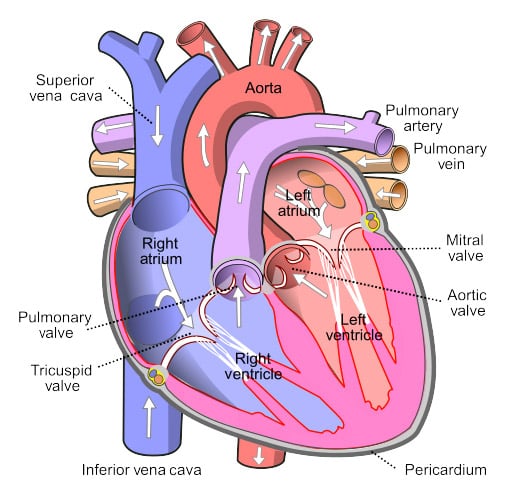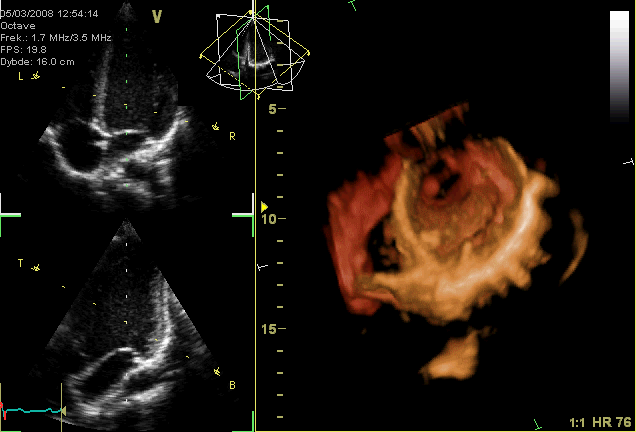Klicken Sie auf Einstellungen, falls Sie diese ablehnen möchten.

Every day, the human heart pumps 10,000 litres of blood through our body. The blood flow in the heart is directed by the heart valves. They act like valves and ensure that the blood only flows in one direction. If the heart valves do not function properly, we notice this through symptoms such as tiredness, fatigue and breathing problems. This also applies to the common heart valve defect "mitral insufficiency", a leakage of the mitral valve - the sail-like intermediate valve between the left atrium and the left ventricle.
The Definition of Mitral Valve Insufficiency
The mitral valve is one of four valves of the heart. It consists of two leaflets attached to tendon threads in the left ventricle.
The function of these leaflets is to open and close the opening (heart valve) from the left atrium to the left ventricle like a valve. The tendon sutures that hold the leaflets in place can tear or shorten due to stress. The leaflets themselves can also perforate or overstretch. In addition, the left heart leaflet may be dilated so that the otherwise healthy mitral valve is no longer able to close the opening completely.
If, due to a leak in the mitral valve (mitral insufficiency), blood no longer flows as intended from the left atrium into the left ventricle, but also back into the left atrium, this leads to congestion of the blood in the lungs. In advanced stages, breathing problems during exertion or even at rest may be the consequence.
 Anatomical sketch of the heart
Anatomical sketch of the heart
The severity of mitral valve insufficiency can be mild, moderate or severe. With "severe mitral valve insufficiency", any physical exertion can become a challenge. Treatment becomes necessary to avoid losing years of life expectancy. An "organic (or valvular) mitral valve insufficiency" is a situation where changes in the mitral valve itself can be identified as the cause. A "functional (or secondary) mitral valve insufficiency", on the other hand, is the result of a deformation of the ventricle, e.g. after a heart attack, which also distorts the leaflets via the tendon sutures and can thus have an effect on the tightness of the heart valve.
If the connective tissue of the mitral valves or the suspension apparatus (tendon threads) is weak and the valve bulges back into the atrium as a result, this is called "mitral valve prolapse". This condition can also be congenital.
Physiological mitral regurgitation" or "minimal mitral regurgitation" refers to the fact that 90% of healthy people have a very slight and harmless leakage while the valves are closing.
The so-called "acute severe mitral valve insufficiency" is a dramatic but rare form, caused, for example, by acute rupture of the tendon filaments in a heart attack or an inflammation of the heart valves. It usually requires immediate therapy.
Mitral valve procedures account for approximately 31% of all heart valve procedures, making it the second most common procedure for heart valve defects.
Symptoms of Mitral Valve Insufficiency
Typical signs of severe mitral valve insufficiency are
- easy fatigability
- shortness of breath on exertion or even at rest
- shortness of breath
- dizziness
- cardiac arrhythmias such as heart palpitations or palpitations.
The cardiologist can also detect changes in blood flow acoustically with a stethoscope.
The time course of mitral valve insufficiency can be very variable and is hardly predictable. However, regular cardiological measurements can detect deterioration at an early stage.
What Causes Lead to Mitral Valve Insufficiency?
The various manifestations of this insufficiency can be caused by the following events
- congenital connective tissue weakness of the valve and its suspension mechanism (mitral valve prolapse)
- inflammation (myocarditis and endocarditis)
- Rheumatic fever (the immune system attacks the inner heart wall and heart valves out of confusion with streptococci)
- heart failure with dilatation of the heart cavities
- heart attack (when the lack of oxygen damages the muscles around the mitral valves)
- dilated cardiomyopathy (in which the ventricle dilates)
- ageing, calcification, degeneration of the valves (causing narrowing and leakage)
- abnormal enlargement of the heart / cardiomegaly (e.g. due to high blood pressure, thyroid problems or anaemia)
- Autoimmune diseases
- genetically caused disorders of the connective tissue metabolism
A change in the leaflets and the holding apparatus that lead to primary mitral regurgitation cannot usually be influenced. However, the prevention of heart disease as a whole can contribute to the prevention of (secondary) mitral valve insufficiency. Secondary mitral regurgitation is the form where the leaflets are not necessarily altered, but the left main chamber is altered due to heart disease, causing the valve to become distorted. The risk factors for heart disease, which you have in your own hands, are the classic ones:
- obesity
- lack of exercise
- unhealthy diet (unhealthy fats and sugar)
- unhealthy diet with development of lipometabolic diseases and diabetes
- smoking
- excessive consumption of alcohol or other drugs
- stress
- Lack of sleep
Our guide at the bottom can give you an idea of how you can gear your lifestyle towards good heart health.
Diagnosis of Mitral Valve Insufficiency
 Ultrasound of the mitral valve. Image rights Wikimedia
Ultrasound of the mitral valve. Image rights Wikimedia
Transthoracic echocardiogram, an external ultrasound scan of the chest wall, usually allows not only confirmation of the diagnosis but also determination of the severity. It can usually also determine a probable cause. The patient's symptoms and the ultrasound readings, in particular, determine the optimal time for an intervention.
With the help of transoesophageal echocardiography (TEE), the cause of mitral regurgitation can be determined and should therefore always be carried out before an operation if the regurgitation is severe. The examination can even usually assess whether the mitral valve should only be repaired or even replaced, and whether an operation via the opened thorax or rather the minimally invasive MitraClip method via groin catheter would be recommended.
Electrocardiograms (at rest or over a longer period of time), or the measurement of electrical currents during heart contraction, can provide information about heart rhythm disturbances that have already occurred.
An Exercise ECG can be used to assess changes in exercise capacity.
The Therapy of Mitral Valve Insufficiency
 MitraClip (heart valve replacement) on the catheter
MitraClip (heart valve replacement) on the catheter
By closing the mitral valve, the backflow of blood should be completely stopped again, symptoms should disappear and patients should regain their full capacity. The traditional treatment is surgery (reconstruction or replacement of the mitral valve through the opening of the chest) or medication (according to the principles of heart failure therapy). However, minimally invasive catheter-based methods have also been available for some years. The most commonly used method is the repair of the mitral valves with so-called "MitraClips".
How is a MitraClip inserted? The heart is gently reached with a catheter via a groin vein so that the mitral valve can be repaired, i.e. sewn together at the leaking point with the help of the clip.
When to use MitraClip? Therapy with MitraClips is recommended when...
- very good results can be achieved with anatomically suitable patients
- even in less suitable anatomy, the leakage is often reduced to such an extent that the symptoms improve significantly
- it is a comparatively very safe procedure
- the result can be checked and, if necessary, corrected during the procedure.
- the stay in hospital and the recovery time after the procedure are usually shorter.
In the video attached below, you can see very clearly the insertion of a MitraClip described here. Another insightful film documentation including interviews with me can be found in the article "MitraClip for Mitral Valve Insufficiency".
Life Expectancy in Mitral Valve Insufficiency
In the case of mild mitral valve insufficiency, without other heart diseases, a normal life expectancy can be assumed.
In the case of severe mitral valve insufficiency, life expectancy is sometimes significantly shortened.
The procedure is not risk-free, nor is it risk-free to wait. If the risk of waiting outweighs the risk of surgery, surgery should be advised.
MitraClip Therapy Today
In the meantime, the procedure has been around for more than 10 years and there is a lot of experience with mitraclip therapy. In many countries it is the standard therapy for patients who do not undergo surgery, with more than 100,000 patients already treated.
Contact us anytime for a cardiology check or your questions about MitraClips. Below we provide a summary and answers to the most frequently asked questions.
Our link recommendations on the topic "Mitral Valve Insufficiency"
Abstract "Mitral Valve Insufficiency"
Mitral valve insufficiency is a common heart valve defect. It is an inability of the mitral valve of the heart to close, also known as leakiness, which leads to a backflow of blood from the left ventricle into the left atrium during the ejection phase (systole). This can be caused by coronary heart disease, cardiomyopathy, a heart attack or a congenital heart defect.
- same as: MI, congenital mitral valve regurgitation, rheumatic mitral valve regurgitation
- Organ: heart
- Symtoms: shortness of breath (dyspnoea), weakness in performance, water in the legs (lower leg oedema), chest pain, fatigue, palpitations (tachycardia), Herzstolpern, Herzrhythmusstörungen, kurze Bewusstlosigkeit, Appetitlosigkeit, Reizhusten, übermässiges nächtliches Wasserlassen
- Tests: ultrasound examination (echocardiography), transesophageal echocardiography / TEE
- Possible treatments: repair of the mitral valve, mitral valve replacement, vasodilating drugs (e.g. glycerol trinitrate), heart rate lowering drugs (e.g. beta blockers)
- Risk factors: hereditary factors, high blood pressure (hypertension), high age, rubella infection during pregnancy, drug or alcohol use during pregnancy, inflammation of the heart muscle (myocarditis), inflammation of the inner lining of the heart (endocarditis), rheumatic fever (streptococcal infection), tonsillitis (streptococcal infection), heart attack
- Possible differential diagnosis: no
The most important questions and answers about "Mitral Valve Insufficiency"
5 Tips for a Healthy Heart
How do I keep my heart fit and healthy? What strengthens the heart?
- Materials needed: -
- Required tools: -
- Time needed: 0.5 h
Steps
-

1 Lose Excess Weight
- Reduce your weight with a combination of long-term adapted, healthy and at the same time enjoyable nutrition and physical activity. Short-term diets often have the opposite effect. Take advantage of the support offered by nutritional counselling.
-

2 Get active!
- Intensive walking, running or cycling that makes you sweat for half an hour several times a week has a beneficial effect on your blood lipid levels.
-

3 Reduce Stress
- Try relaxation techniques such as yoga, meditation, walks, pets or talking to your loved ones.
- Get enough sleep.
- People with irregular daily routines are more likely to have sleep disorders, depression and heart attacks. Spare yourself by simplifying your life.
- Loneliness can be a stress factor and leads to a higher risk of heart disease. Enjoy the balance that social contact can bring.
-

4 Eat a Heart-Healthy Diet!
- Eat plenty of fresh vegetables, salads and fruits in all variations.
- Replace saturated fats with unsaturated fats: Replace sausages, fried foods and dairy products with olive oil, nuts, seeds and vegetarian or even vegan meals.
- Do not consume more than the WHO recommended amount of 5g of salt per day. Use dietary aids, as salt is in many different foods (e.g. in cheese).
- If you are dealing with heart failure, drink no more than 1.5 litres of fluid per day.
- Make sure you don't eat more calories than you consume each day. An app can help you learn and discover where the fatteners are hiding. Or which type of exercise burns how many calories. It's interesting and fun!
-

5 Consume Stimulants with Caution
- Give up smoking. Use tools such as workshops, nicotine supplements and books to do so.
- Restrain yourself from alcohol and drink very little of it.
- Drinks containing caffeine, such as coffee, black tea, green tea, cola and energy drinks, but also dark chocolate can stimulate the heart and metabolism depending on habituation and increase blood pressure for 20-30 minutes (be careful when measuring). 400 milligrams per day is considered the recommended upper limit. Caffeine can increase cardiac arrhythmias. If you experience unwanted discomfort: Water helps to eliminate caffeine.